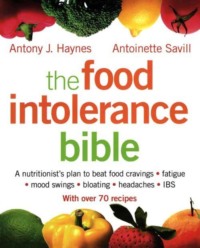Czytaj książkę: «The Food Intolerance Bible: A nutritionist's plan to beat food cravings, fatigue, mood swings, bloating, headaches and IBS»

The Food Intolerance Bible
A nutritionist’s plan to beat food cravings fatigue mood swings bloating headaches IBS
Antony J. Haynes and Antoinette Savill

Table of Contents
Cover Page
Title Page
Introduction
Part One Do I Have a Food Intolerance?
1 How Can I Tell If I Have a Food Intolerance?
2 What Tests Can Confirm Food Intolerance?
Part Two Why Do I Have a Food Intolerance?
3 Is It What I Eat?
4 Digestive Difficulties
5 Digestive Enzymes, Yeasts and Parasites
6 How Healthy Is My Intestinal Ecology?
7 ‘Uninvited Guests’
8 Prescription and Over-the-Counter Drugs
9 Intestinal Immunity
10 The Stress Factor
11 Leaky Gut Syndrome
12 The Weight Connection
Part Three Your Action Plan to Beat Food Intolerance
13 Food Intolerance Action Plan
14 Elimination and Challenge or Exclusion Diet?
15 Your Supplement Plan
Part Four What Can I Eat?
16 Introduction to the Recipes
17 Useful Ingredients
18 Recipes
Soups
Vegetarian Dishes
Pasta
Appendices
Appendix I How to Do a Pulse Test
Appendix II Food Intolerance Lab Tests and Where to Get Them
Appendix III Other Lab Tests Available
Appendix IV Supplement Information and Websites
Appendix V Foods Containing Salicylate
References
Bibliography
Resources
Index
Copyright
About the Publisher
Introduction
Why Should I Read this Book?
Do you frequently experience abdominal bloating, even when you haven’t over-eaten?
Do you have symptoms of Irritable Bowel Syndrome?
Do you have periods during the day when your brain simply does not work as it should?
Do you suffer from mood swings?
Are you abnormally tired?
If your answer is ‘yes’ to one, two or more of these questions, then you may well be experiencing the effects of an intolerance to one or more foods.
You may have picked this book up because you know or suspect that you react adversely to a food or foods. This book is all about food intolerances and how to deal with them and with connected conditions ranging from Chronic Fatigue Syndrome (ME), an overgrowth of the yeast Candida albicans (thrush), leaky gut syndrome, excessive stress, parasitic infections, Irritable Bowel Syndrome (IBS), brain fog and even skin conditions such as eczema and respiratory problems such as asthma.
Main Aims of this Book
1. To help you to understand what an intolerance is and discover whether or not you have one (or more) or not
2. You will learn about various ways of confirming your hunch that you have a food intolerance.
3. You will be shown why you might have food intolerances, and their causes and connections with other conditions. This will help you to identify which of these may be relevant to you in addition to food intolerances. The longer you have had food intolerances, the more likely it is that you will have other, related conditions as well.
4. You will be presented with an action plan for dealing with food intolerance and improving digestion. Putting the action plan to work is made all the more possible by the great recipes prepared by Antoinette, which are free of the most common foods to which people have an intolerance. The recipes are designed to give you a head start and make it as easy as possible to implement the necessary changes in your diet. While this can often require no small effort, if food intolerance is to blame it is vital to helping you overcome your symptoms.
5. To help you improve your health by helping you to identify what your food intolerances are, the connected conditions and how to deal with them.
Throughout this book there are questionnaires to help you assess your health and to chart your progress back to better health.
Food Intolerance or Food Allergy?
Before going any further I am going to clarify the distinction between a food allergy and a food intolerance. This has been a source of confusion, not least for those in the health profession.
Originally, the word allergy was designated to mean any adverse reaction to any substance inhaled or eaten or coming into contact with the skin, with no specific limitations on the specific nature of the immune reactivity. However, over time, the term food allergy has been taken on by allergists and relates to immune reactions mediated by the immunoglobulin E (IgE), which could be to a food or something inhaled or to which we might come into direct physical contact.
Immunoglobulin is a protein that carries out various roles in the body’s immune response. There are five: immunoglobulin G, A, M, D and E. Immunoglobulin G (IgG) plays the most significant role of the five in terms of food intolerance, whereas immunoglobulin E (IgE) triggers the most significant reactions. However, not all food intolerance reactions are related to our immune system. For example, tyramine – found in strawberries, cured meats and cheese – can trigger migraines in some people, and this is a brain reaction, not an immune-based one.
Reactions mediated by IgE are referred to as ‘true food allergies’ – somewhat of a misnomer since it implies that any other type, such as a food intolerance, is ‘untrue’. Having said this, these true food allergy reactions are almost always immediate in their manifestation and therefore most often can be traced back to a particular cause. They can often affect health in a significant and rapid manner – swollen lips and tongue, asthma attack – reactions can be life-threatening, which is why great care needs to be taken to avoid the trigger foods or substances. Peanut allergy and shellfish allergy, for example, are perhaps the most well known. Another example is an allergy to latex (rubber) – of allergies triggered just by coming into contact with a substance, this is the one on the most rapid increase. So much of a problem is this specific allergy that at least one hospital has had to change the material of its surgical gloves lest a nurse or doctor succumb to anaphylaxis.
Anaphylaxis is an extreme physical reaction – the reason for which is not fully understood – that often requires adrenaline to counter the extreme stress-reaction caused in the body.
Allergy Is on the Increase
While allergies affect a far smaller proportion of the population than food intolerances, their effects are not insignificant. Unfortunately, allergies are on the increase – some 50 million Americans suffer from some type of allergy on a yearly basis. According to the American Academy of Allergy, Asthma and Immunology, allergy is ranked as the sixth leading cause of chronic disease today, at a cost of $18 billion a year. It is believed that the evidence from the UK is very similar to that in the US. Two recent estimates of the prevalence of allergy in the US were 9 per cent and 16 per cent, and the prevalence of the two most common allergies, atopic dermatitis (dry skin, similar to eczema) and allergic rhinitis (persistent runny nose), have been increasing since the mid- to late 1980s.
Food Intolerance Is Escalating, Too
As mentioned, food intolerance is the name for reactions mediated by immunoglobulin G (IgG). These reactions can manifest up to 72 hours after exposure, making the trigger food or substance much more difficult to identify. However, it is worth noting that some food intolerance reactions are not typically mediated by immune reactivity.
While people who suffer from IgG reactions rarely need immediate medical attention, the symptoms can certainly reduce their quality of life and cause longterm illness. The proportion of the population who suffer from at least one food intolerance is as much as 45 per cent (and that may be a conservative estimate), making it a significant issue in the nation’s health.
Evidence shows that the prevalence of food intolerance is escalating, but because the methodology used to analyse food intolerance is more recent than that for IgE allergy, there are no hard-and-fast figures to compare with the prevalence of decades ago.
At least 45 per cent of the population suffer from food intolerance.
A Wide Range of Symptoms
The range of food intolerance symptoms is as long as it is diverse. You would hardly believe that so many symptoms could be attributable to food intolerance. Simply having interviewed thousands of clients who have avoided certain foods for periods of time and then reintroduced them into their diets, and having listened to their observations about their symptoms, confirms the existence of food intolerance. There is also much evidence today based on the evidence of immunological testing that food intolerance does exist (although, as stated above, not all food intolerances are mediated by immune IgG activity). In spite of all the evidence, however, there are some who refuse to acknowledge food intolerance as an issue, and in particular as a reaction that can cause mental symptoms. This is an issue that I would like to clear up right now, so the rest of this Introduction is devoted to showing you evidence, some of it many years old and some of it very recent, that proves the existence and relevance of food intolerance to a wide range of symptoms.
The Author’s Personal Experience
I have suffered with food intolerances myself. I have had a gluten intolerance for years, as measured on more than one occasion with lab tests. To this day I am unable to eat wheat without experiencing unpleasant symptoms. I also have a soy intolerance, this one tested by IgG analysis, that causes sinusitis which only resolves when soy is avoided and which re-emerges when soy is eaten again. I could have figured out what the foods were by observation if I had known what to look for! In hindsight, the reason for these adverse reactions is obvious since I committed the first sin in terms of food intolerance: eating a lot of a certain food on a regular and repetitive basis. You will discover the reasons behind your own intolerances later in this book.
An Ancient Condition
That food can cause adverse symptoms has been appreciated for thousands of years. Herodotus in 460 BC was reported to have said that ‘One man’s meat is another man’s poison.’ Hippocrates also identified that stomach upset and skin hives could be caused by drinking milk. It is also something that has been acknowledged and appreciated in medical and academic papers for over a hundred years, but this peer-reviewed literature has not always been given the credence it deserves. It is because of this lack of appreciation for what might be causing a variety of symptoms that uncertainty has been created, and an assumption that such-and-such a symptom must be due to something else, like stress. However, we are now in an age where food intolerance affects at least 45 per cent of the population and it has become such an issue that people are seeking out the answers for themselves. Since a food intolerance does not represent a pathology for which there is a medical treatment – by contrast, a food allergy has the potential to do much harm and does require medical attention – there has been much less medical attention focused on this subject. With the march of the masses who suffer from adverse reactions, however, the development of tests, research and investigations into the topic now provide previously unheralded recognition that food intolerance is very real and, unfortunately, a significant factor in many people’s health.
I predict, unwillingly and hoping that I will be proven wrong, that with modern lifestyles and our food supply being what they are, food intolerance will increase in the coming years, making it a major cause of unpleasant symptoms for decades to come.
Putting Food Intolerance into Context
However, to place the blame entirely on food intolerance does not properly put the increasing prevalence into context. This assumes that the food is the problem, just like the bacteria is the problem for which the solution is antibiotics. In this example, the germ-warfare approach misses the point which Louis Pasteur, founder of modern-day antibiotics, regretted in his latter days when he said, ‘C’est le terrain, pas le germ’ which, translated means: It is the host (i.e., the environment or the body) and not the germ (bug, microbe, bacterium, virus) that is important.
In this way, those who believe that stress causes the symptoms have a point, because this can create imbalances within the ‘host terrain’ (i.e. your body) that permit or make it react inappropriately to foods.
In later chapters you will learn about the connections between stress and food intolerance as well as other underlying issues. These also include imbalances within the digestive system in terms of maldigestion and the graphically-termed ‘leaky gut syndrome’, and imbalances in the micro-organisms living within our intestines, from yeasts to bacteria and parasites. You will be shown how to address your food intolerances as well as how to address the underlying imbalances. However, it is worth noting that this is not a book designed to assess allergies that require medical attention. More on this in Chapter 1.
Proof of Food Intolerance
There have been observations that food can elicit adverse reactions since the days of Hippocrates. As you will find out in Chapter 1, there are potentially a vast range of symptoms that can be caused by food intolerance reactions. These can be divided into two broad categories: physical (especially digestive) and mental/emotional/behavioural. Since the nature of the symptoms is so diverse, there could potentially be other contributory factors, too, and it is this lack of specificity which has cast some doubt about the phenomenon of food intolerance.
So, can you prove that food intolerance is really the cause of your symptoms? In many cases, you may not need any more proof other than the fact that when you avoid a food you do not get a symptom, but when you eat it you do. In other cases you may have a suspicion about a certain food and therefore an approach which involves elimination/reintroduction – removing the suspected food from your diet and later on reintroducing it into your diet – may serve a useful purpose. (This is not a good thing to do if you have a true food allergy, however). Alternatively, you may wish to implement the pulse-testing method, which will be described later.
However, there are some people who have a potential for multiple food intolerances, which makes an elimination diet and reintroduction difficult to implement. In these cases, a test to tell you which foods you react to would be very useful.
Most people in this situation want to have a firm diagnosis of what is causing, or contributing to, their problems. Equally, practitioners also want to have some certainty about what is wrong with their patients so they can make the most apt recommendations. To this end, a degree of proof is always useful – and in Chapter 2 you will find descriptions of a number of accurate tests to help you gather this proof. However, simply testing for immune reactions does not prove in itself that this is the cause of your symptoms; there can be a number of foods to which you are intolerant that cause you no symptoms at all. This is where the avoidance of these foods and a monitoring of symptoms can ‘prove’ the point nicely. The reintroduction of the offending foods should trigger, in a way that can be easily reproduced, your symptoms.
There have not been many large studies conducted to ‘prove’ how food intolerance affects various aspects of health. However, there have been studies that show very strong evidence of cause and effect between food intolerance and Irritable Bowel Syndrome (IBS). Indeed, one complaint a medical doctor friend of mine raised about this issue was that he wasn’t particularly aware of any ‘decent’ studies showing that food intolerances really were to blame for a number of symptoms they are claimed to cause. One of the very good reasons for this is that typical medical studies (randomized, placebo-controlled, double-blind studies) are designed to test a drug against a sign or symptom. They are not designed to evaluate the effects of a number of different agents (i.e. foods) on multiple variables (i.e. symptoms). Furthermore, in the case of food intolerance, since the technology for testing is relatively new and because there is no one single test that will accurately identify every single food to which an individual may react, there is difficulty in verifying exactly what foods should be assessed.
Food Intolerance and IBS
IBS was the subject of a recently published study in the respected journal Gut, which showed that food intolerances are very much involved in Irritable Bowel Syndrome (IBS). It proved what most complementary practitioners have known all their professional lives.
The study involved 150 out-patients with IBS who then had an IgG food intolerance test. They were not shown their results. Seventy-five of the participants were provided with diets that excluded the foods to which they had raised IgG antibodies, while the other 75 participants were given ‘sham’ diets that excluded foods to which they did not have raised IgG levels. A number of symptoms of IBS were compared before and after the diet for 12 weeks. The conclusion was that a diet that eliminates foods to which you have a raised IgG level is indeed effective in reducing the symptoms of IBS.
You may say that this is an obvious finding and you might have expected as much, but the current treatment of IBS is based largely on the use of antispasmodics, antidepressants and medications that alter bowel habit, depending on whether constipation or diarrhoea is the predominant problem. This is usually unsatisfactory, however, and encourages patients to seek out alternative treatment. Of course, if food intolerance is to blame for the symptoms, even if not wholly, then the most sensible first-line approach would be to change your diet. This would make recourse to medications the alternative path.
This study represents an important landmark in acknowledging the importance of food in triggering or causing IBS. The patients had experienced symptoms for over a decade and were found to be sensitive to approximately six to seven foods each, on average. Those who fully adhered to the diet showed the greatest improvement.
The reintroduction of the culprit foods also caused their symptoms to get worse. The patients did not embark on anything other than eliminating the culprit foods: They did not take any digestive enzymes, nor anything to restore low stomach-acid levels. They did not supplement with ‘friendly’ bacteria to combat any possible yeast overgrowth. They did not take active steps to heal their intestinal lining, nor did they take active steps to reduce their stress levels. If these things had been addressed, it is likely that their improvements would have been even greater.













